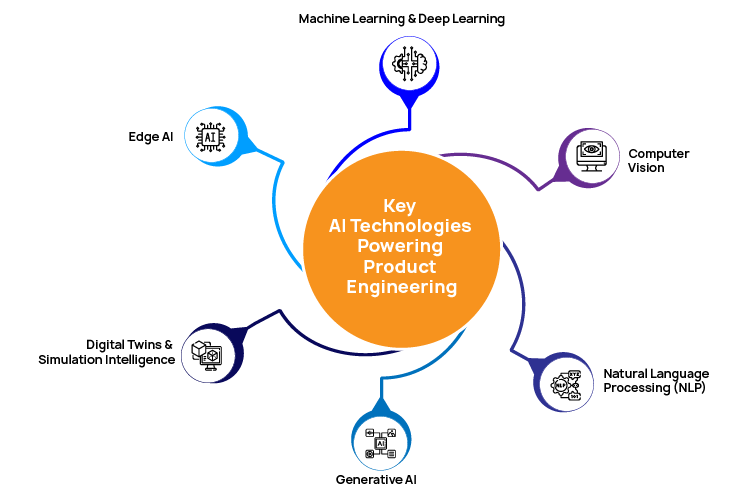

ACL Digital
5 Minutes read
Navigating the Fourth Industrial Revolution: The Convergence of AI and Product Engineering
The Fourth Industrial Revolution, often called Industry 4.0, is not merely an extension of automation but a radical shift driven by the fusion of physical products and digital intelligence. At its core lies the convergence of Artificial Intelligence (AI) and product engineering, fundamentally transforming how next-generation products are conceived, developed, and evolved.
AI is no longer an isolated technology layer; it is embedded deeply within the engineering workflow, automating decision-making, enhancing design precision through data-driven simulations, and enabling real-time system adaptability. From intelligent product configurations to predictive behavior modeling, AI augments the engineering lifecycle by converting raw sensor data and user interactions into actionable insights. Engineering teams can move beyond static designs to create dynamic, context-aware, and self-optimizing products. This blog explores the deep integration of AI into product engineering disciplines, highlighting its pivotal role in accelerating innovation cycles, enhancing operational efficiency, and infusing intelligence into every stage of product development.
Understanding the Core of Product Engineering in the Industry 4.0 Era
Modern product engineering in the Industry 4.0 landscape is defined by its ability to integrate intelligent software, embedded systems, and real-time connectivity into the fabric of physical products. It extends beyond traditional mechanical and electronic design, encompassing system-level thinking that fuses AI, data analytics, edge computing, and cyber-physical interactions. The scope now includes not just product development but the entire lifecycle—from ideation and digital prototyping to predictive maintenance and post-deployment optimization.
Traditionally, product engineering followed a linear and compartmentalized lifecycle design, prototype, validate, manufacture, and release, largely dependent on historical data and manual iterations. However, the AI-enhanced product lifecycle is iterative, adaptive, and data-driven. It leverages machine learning for continuous design validation, automates performance simulation, and uses feedback loops from connected devices to evolve product features in near real-time. This evolution is fueled by the growing demand for intelligent, connected, and adaptive products that respond dynamically to environmental conditions and user behavior. Whether it’s a self-learning thermostat or an autonomous vehicle ECU, today’s products are expected to process contextual data, optimize their functions autonomously, and seamlessly integrate into broader ecosystems. As a result, product engineering is no longer just about building things—it’s about engineering intelligence into them.
Key AI Technologies Powering Product Engineering
As AI becomes central to modern engineering, key technologies enable the shift from reactive workflows to intelligent, predictive product development:

- Machine Learning and Deep Learning: ML algorithms are central to predictive modeling—used to forecast performance issues, material fatigue, or environmental failures before they occur. Deep learning further enhances this by identifying hidden patterns in high-dimensional sensor data, enabling adaptive control systems and automated defect detection with millisecond precision.
- Computer Vision: Used extensively for automated inspection and quality assurance, computer vision systems can identify surface anomalies, assembly misalignments, and structural deformations in real-time. Vision-enabled robotic arms use this technology in manufacturing environments for precision alignment and dynamic part recognition.
- Natural Language Processing (NLP): NLP helps engineering systems understand and process unstructured data such as user feedback, maintenance logs, or service tickets. It is also being integrated into product design platforms to generate intelligent documentation, interpret design intent from textual inputs, and power AI-based design assistants.
- Generative AI: Going beyond automation, generative AI models can rapidly explore design spaces, create new component geometries, and auto-generate schematics or embedded code. This dramatically reduces design iteration cycles while adhering to functional, thermal, and manufacturability constraints.
- Digital Twins and Simulation Intelligence: These virtual replicas of physical systems provide real-time insights into product behavior under varying conditions. AI enhances digital twins by enabling continuous learning from operational data, allowing real-time prototyping, stress testing, and predictive maintenance simulations—all before physical deployment.
- Edge AI: Bringing intelligence closer to the source, Edge AI allows real-time decision-making directly on the product or embedded system. This is crucial for latency-sensitive applications like autonomous navigation or industrial machinery control, where immediate responses to environmental data are essential.
Real-World Applications and Use Cases
AI-driven engineering is already reshaping categories like wearables, smart appliances, and consumer health tech. Below are key real-world applications where AI is transforming engineering outcomes:
- Smart Consumer Electronics: AI enables adaptive user interfaces that learn from behavioral patterns to personalize real-time experiences. Devices such as smart TVs, voice assistants, and intelligent appliances utilize embedded AI to perform on-device learning, enabling seamless multi-user context recognition, proactive system updates, and dynamic feature adjustments.
- Automotive & Mobility: AI is central to modern vehicle architectures, powering everything from advanced driver assistance systems (ADAS) to full autonomy. Embedded AI models process data from LIDAR, radar, and vision sensors for real-time object detection, trajectory prediction, and decision-making. Sensor fusion techniques improve environmental awareness, while onboard AI controllers adapt driving dynamics based on road and user behavior.
- Healthcare Devices: In the medical domain, AI accelerates diagnostics and enhances wearable intelligence. Devices equipped with ML models analyze real-time biosignals to detect anomalies such as arrhythmias or glucose level fluctuations. AI-powered imaging modules assist in radiological analysis, while adaptive algorithms personalize treatment recommendations based on continuous patient monitoring.
- Industrial IoT Products: AI transforms industrial environments with intelligent edge-enabled devices that continuously monitor equipment health, optimize energy usage, and predict system failures. Machine learning models process multi-modal sensor data for anomaly detection, reducing unplanned downtime and enhancing predictive maintenance accuracy across smart factories and critical infrastructure.
Benefits of AI Integration in Product Engineering
The integration of AI into engineering workflows delivers transformative benefits:
- Faster Time-to-Market with Intelligent Automation: AI streamlines time-intensive tasks such as design validation, testing, and iteration cycles through autonomous simulation and intelligent rule-based systems. Machine learning accelerates decision-making by predicting design outcomes early in the cycle, while generative algorithms automate multi-variable design exploration, enabling engineering teams to deliver functional prototypes in a fraction of traditional timelines.
- Reduced Design and Development Cost: AI-driven automation minimizes manual rework and reduces dependency on physical prototyping by enabling high-fidelity virtual models and simulation-based validation. Predictive analytics helps avoid late-stage failures, reducing costly recalls or redesigns. Additionally, optimized resource utilization and real-time feedback loops contribute to leaner engineering workflows.
- Enhanced Product Reliability and Customer Personalization: By leveraging continuous data from connected devices, AI enables real-time condition monitoring, fault prediction, and automated calibration, significantly improving product durability and reliability. On the personalization front, embedded AI adapts product behavior based on individual usage patterns, offering dynamic feature tuning and enhanced user satisfaction without requiring manual configuration.
- Scalable Product Intelligence and Lifecycle Optimization: AI transforms static products into adaptive systems that evolve post-deployment. Real-time learning from operational data allows predictive maintenance, firmware enhancements, and feature updates over-the-air. More importantly, the intelligence is scalable—AI models trained on one product variant can be adapted across product families, reducing time and cost for future development cycles.
Challenges and Considerations in AI-Driven Product Engineering
As AI becomes a foundational layer in modern product engineering, it introduces a new set of technical challenges that extend far beyond traditional development constraints. Below are the following key areas:
- Data Quality and Model Accuracy: The performance of AI models is only as good as the quality and relevance of the data on which they are trained. In product engineering, sensor data can be noisy, unstructured, or incomplete, compromising predictive accuracy. Engineering teams must implement robust data curation pipelines, domain-specific feature engineering, and continuous validation strategies to ensure model fidelity across varying operating conditions.
- Explainability and Transparency in Design Decisions: AI-driven recommendations in design or system behavior must be explainable, especially in regulated industries like automotive, aerospace, or healthcare. Black-box models without interpretability can lead to compliance risks and engineering blind spots. Incorporating explainable AI (XAI) techniques—such as saliency maps, feature attribution, or rule-based surrogates—helps engineers validate AI behavior and build trust in automated decisions.
- Hardware-Software Co-Design Complexities: Embedding AI in products requires a tightly coupled hardware-software integration, particularly when deploying models on constrained edge devices. Co-design challenges include optimizing neural networks for low-power execution, managing real-time constraints, and ensuring hardware compatibility with AI toolchains. Model quantization, pruning, and on-chip accelerators must carefully align with system-level performance goals.
- Talent Gap in AI and Engineering Integration: Bridging traditional engineering expertise with AI competencies remains a significant bottleneck. While mechanical and embedded engineers excel at system-level design, AI implementation demands knowledge in data science, ML ops, and algorithm optimization. Organizations must invest in cross-functional teams and upskilling programs to build hybrid engineering capabilities capable of handling full AI-embedded workflows.
- Managing IP, Security, and Compliance in AI Systems: AI introduces new vectors for IP leakage, model inversion attacks, and unauthorized access to inference systems. Additionally, training datasets often include sensitive operational data, raising concerns around privacy and compliance. Secure model deployment, encrypted inference pipelines, and AI-specific compliance frameworks (like ISO/IEC 24029) must be part of the engineering lifecycle to ensure responsible AI deployment in products.
The fusion of Artificial Intelligence and product engineering is redefining the foundation of Industry 4.0. No longer confined to automation or isolated intelligence layers, AI now powers dynamic product ecosystems—enabling real-time adaptability, hyper-personalization, and continuous learning across the entire lifecycle. As engineering moves from static design to AI-augmented development, the shift calls for a mindset change, where products are not just built but evolved through intelligent platforms and data-driven decision-making.
Enterprises and engineering teams must act now to stay ahead of this curve. Investing in intelligent engineering platforms, AI-native workflows, and multidisciplinary talent will be key to future-ready product development. ACL Digital is at the forefront of this transformation, empowering global organizations with AI-embedded solutions, edge intelligence, and domain-specific ML capabilities. From concept to deployment, we enable our clients to engineer smarter, adaptive, and scalable products for the digital future.
Connect with our experts to discuss this in more detail.
Related Insights


Death to Prompting! Long Live Programming!

The Architecture of Agentic RAG: Reasoning-Driven AI Systems Explained


The AI Developer’s Guide to Data Formats: TOON vs. JSON and Beyond

